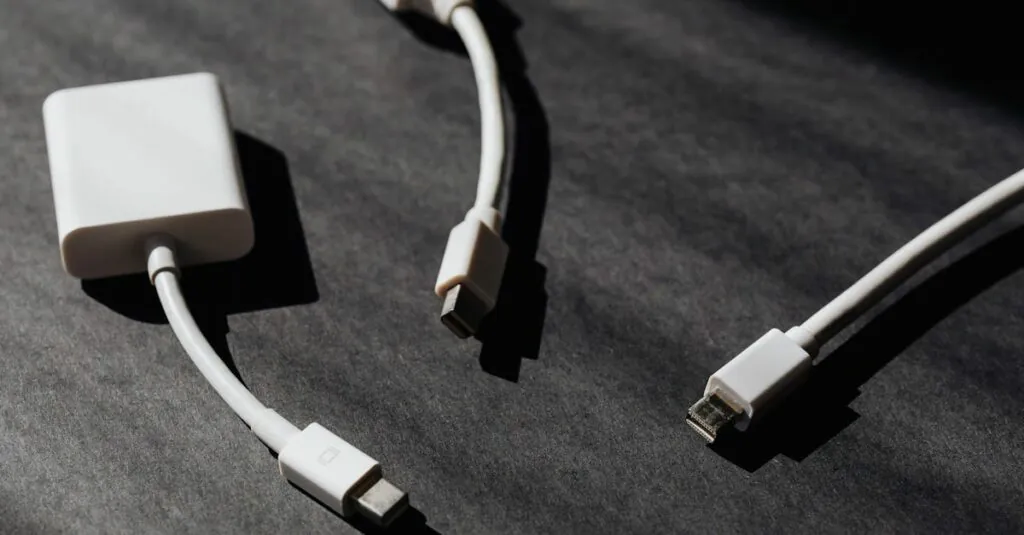Table of Contents
ToggleImagine this: you’ve just taken the perfect shot of your cat wearing a tiny sombrero, and now it’s taking up precious space on your iPhone. With all those adorable photos piling up, transferring them to an external hard drive might just be your ticket to digital freedom. But can you really do it? Spoiler alert: yes, you can!
Overview of iPhone Photo Management
Managing photos on an iPhone involves several options for users. Users can store images in the Photos app, which offers organization through albums and intelligent sorting features. Cloud storage options like iCloud provide additional backup solutions, enabling access to photos across devices.
External hard drives serve as practical solutions for those seeking to offload large quantities of images. Transferring photos not only clears space, but it also preserves memories securely. Most users prefer a combination of device storage and external backup for comprehensive photo protection.
Selecting the right method for transferring images depends on personal preference. USB cables allow direct connections between iPhones and external drives, facilitating easy file transfers. Third-party applications can also streamline the process, offering user-friendly interfaces for importing and exporting images.
Recent updates to the iOS software improved the efficiency of photo management. New features include enhanced file sharing options and compatibility with various external drives. Using these updated tools simplifies the transfer process and enhances overall user experience.
Regularly organizing and backing up photos ensures easy access and prevents data loss. Users find it beneficial to periodically review their photo libraries and identify images for transfer. Establishing a routine for managing photos on the iPhone increases both productivity and organization.
Methods to Transfer Photos
Transferring photos from an iPhone to an external hard drive can be accomplished through various methods. Each option offers unique advantages in terms of speed, convenience, and user preference.
Using a Computer as an Intermediary
Utilizing a computer simplifies the transfer process significantly. Connect the iPhone to the computer using a USB cable. Open the Photos app or file explorer on the computer to view the device. Selecting the desired photos permits easy copying to the computer’s local storage. Afterward, transfer images from the computer to the external hard drive. This method provides a secure pathway to manage and store large volumes of photos efficiently.
Direct Transfer Options
Direct transfer options streamline the process, minimizing the steps involved. Some external hard drives support direct connection to the iPhone through a Lightning port. Using compatible apps available on the App Store enhances functionality, allowing users to manage their photos smoothly. Many hard drives feature built-in wireless options, enabling seamless transfers without the need for cumbersome cables. This approach saves time and keeps the process intuitive for all users.
External Hard Drive Requirements
External hard drives offer a reliable solution for transferring and storing iPhone photos. Users must consider specific requirements to ensure a successful transfer.
Compatibility Considerations
Different external hard drives come with varying compatibility features. Choosing a drive with USB-C or USB-A connections simplifies the process for most users. Drives supporting Apple File System enable seamless access for iPhone users. Additionally, it’s crucial to check whether the drive has MFi certification for direct connections, which ensures the drive works perfectly with iOS devices.
File System Format
The file system format of the external hard drive plays a significant role in the transfer process. Drives formatted in exFAT support large file transfers, making them ideal for high-resolution images. NTFS drives may require additional software for compatibility with iOS, while APFS suits Mac users best. Formatting the drive correctly before transferring photos prevents potential issues and streamlines the entire process.
Step-by-Step Transfer Guide
Transferring photos from an iPhone to an external hard drive involves straightforward methods. Users can choose between macOS and Windows systems for this task.
Using macOS
To transfer photos on macOS, first connect the iPhone to the computer using a USB cable. Open the Photos app, which automatically detects the device. Select the photos, then click “Import” to bring them into the Mac. After importing, access the external hard drive through Finder. Drag the imported photos from the Photos library or designated folder to the desired location on the external drive. Ensure the external drive is formatted correctly, preferably in exFAT, to maintain compatibility with iOS files.
Using Windows
Connect the iPhone to a Windows PC via USB. A prompt appears on the iPhone; tap “Trust” to grant access. Open File Explorer, and locate the iPhone under “This PC.” Navigate to the “Internal Storage,” then “DCIM” folder, where photos are stored. Select the images for transfer and copy them. Finally, paste the copied files onto the external hard drive. Verify the external drive’s format, ensuring it is recognized by Windows, typically using exFAT or FAT32 to avoid potential issues during the transfer process.
Common Issues and Troubleshooting
Transferring photos from an iPhone to an external hard drive can encounter several common issues. Users may experience connectivity problems if the iPhone is not recognized by the computer or drive. Check the USB cable for damage or compatibility issues. A faulty cable often hinders the transfer process.
Problems can also arise with file formats. Images may not transfer correctly if the external hard drive is formatted in NTFS. Formatting the drive in exFAT or FAT32 contributes to compatibility with various systems. Users should always verify the drive’s format before proceeding.
Missing photos during transfer might occur due to permissions settings. Granting appropriate access on both the iPhone and the computer is essential. They must enable file sharing settings in order to avoid this issue.
Occasionally, users may face insufficient storage space on the external hard drive. Monitoring available space helps prevent interruptions during the transfer. Deleting unnecessary files or moving them elsewhere frees up space for new images.
Additionally, software updates may affect the transfer process. Ensuring the iPhone and computer software is up to date can resolve bugs or compatibility problems. They should periodically check for updates to improve functionality.
If direct transfer options fail, utilizing a computer as an intermediary can help. First, transfer images to the computer and then move them to the external hard drive. This method often circumvents issues associated with direct connections.
Lastly, if an error message appears, restarting the devices can clear glitches. A simple reboot often resolves temporary connectivity issues. Taking these steps should streamline the photo transfer process and mitigate common problems.
Transferring photos from an iPhone to an external hard drive is a practical solution for anyone looking to manage their digital memories effectively. By utilizing the right methods and ensuring compatibility, users can easily free up space on their devices while keeping their cherished photos safe. Whether opting for direct transfers or using a computer as an intermediary, the process is straightforward and enhances photo organization. Regular backups and proper formatting of external drives are essential for seamless transfers. With these strategies, users can enjoy a clutter-free iPhone and peace of mind knowing their memories are securely stored.




